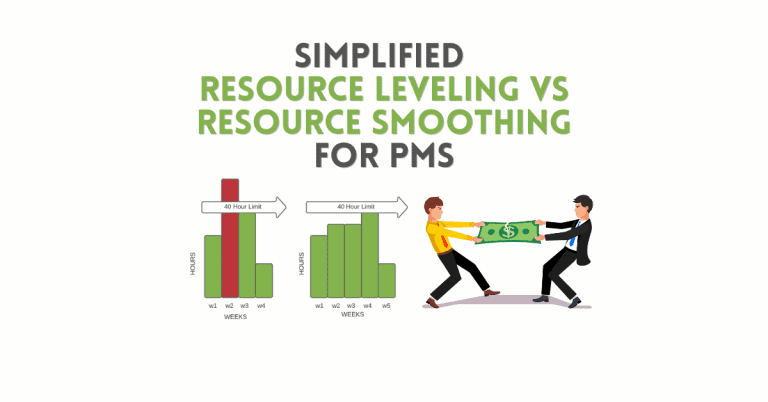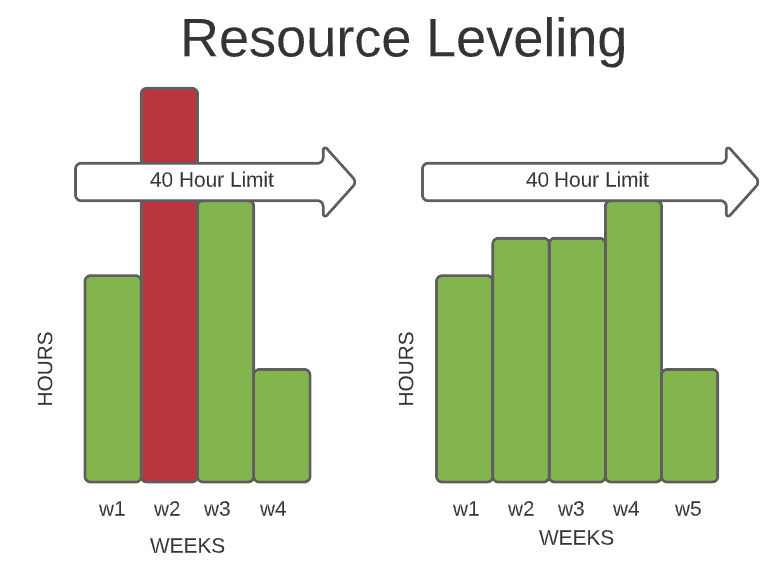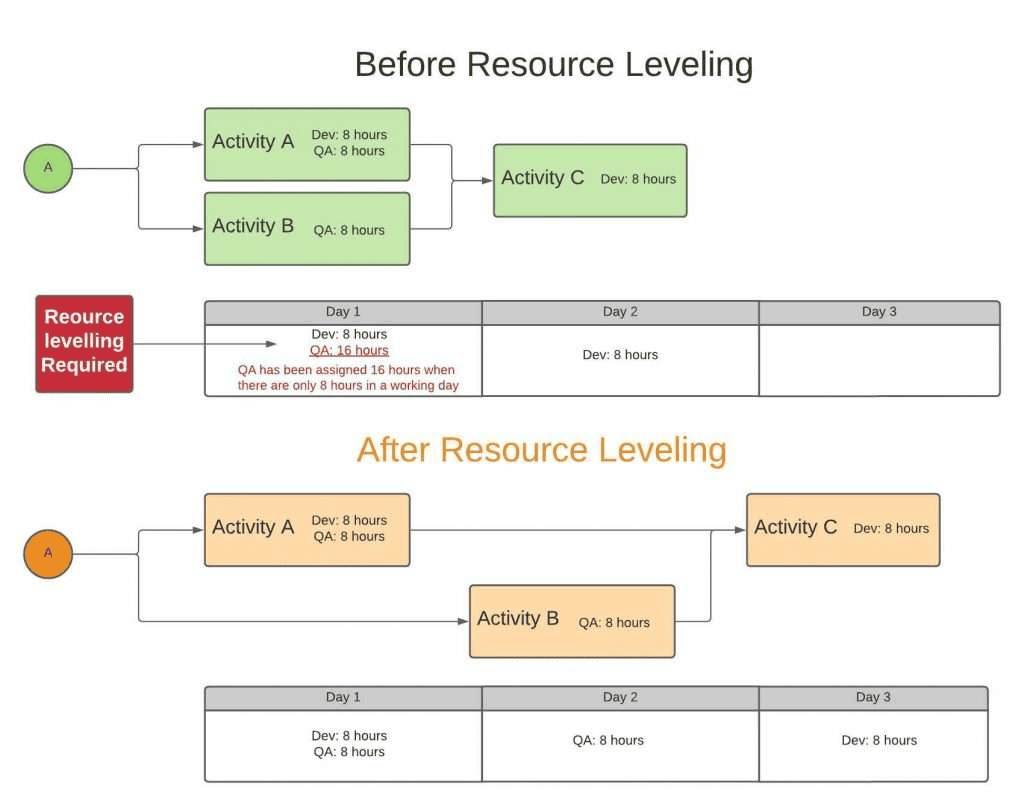Advantages of Resource Leveling vs Resource Smoothing

Each project task requires a resource that can follow the project budget and schedule. As the project progresses, unexpected events and challenges may force you to reconsider your resource allocation. In this case, you must adapt to ensure that project deliverables are unaffected. This is where resource leveling comes into play.
Resource leveling aims to adjust timelines to ensure the project is completed with all available resources. In turn, you will assign resources according to your goals and objectives. In other words, it is a management strategy that helps overcome staff-level constraints.
Project managers must use their resources efficiently to achieve project objectives. To this end, solid resource management skills and a deep understanding of each project’s needs are needed to level the playing field. This article will discuss examples of resource leveling, resource leveling vs. resource smoothing, the best time to use each, and when schedule optimization is ideal.
Resource Leveling PMP Definition
A technique in which start and finish dates are adjusted based on resource constraints with the goal of balancing the demand for resources with the available supply. Resource leveling can be used when shared or critically required resources are available only at certain times or in limited quantities, or are over-allocated, such as when a resource has been assigned to two or more activities during the same time period, or there is a need to keep resource usage at a constant level.PMBOK 6.5.2.3
Resource Leveling
Leveling resources is a project management technique. It involves resolving scheduling or overall conflicts to ensure a project can be completed using the available resources. Resources are the time, materials, or tools required to complete a project resource plan.
It is a way to maximize the resources available while still working within the project’s cost, time, and scope constraints. Project managers can have difficulty balancing multiple projects’ demands for the same resources.

Businesses use tools to level resources when a project environment changes and impacts resource levels. This could be, for example, when a team member is fired or a stakeholder’s requirement changes.
How to do Resource Leveling
These techniques prevent resources from being overstretched while ensuring that projects have everything they need to succeed. This strategy helps with project management and helps the team maintain a healthy work-life balance. Here are a few reasons resource optimization can help your project and team.
- To make the most out of your resources
- To keep deficits to a minimum
- To avoid task overloads among team members
- To ascertain that the project out is of high quality
Resource Leveling Example:

Some resource leveling examples include:
1. One example is deferring the start of a project.
A project necessitates creating mock-ups for the customer, but the designer is double-booked, and the rest of the team is also busy. When the designer becomes available, they begin the job two days later. Because the designer works quickly, the project’s completion date remains unchanged.
2. Obtaining additional resources is another example.
The IT department has been dealing with a flood of IT demands related to a virus that has infected business systems. The team decided to invest in new antivirus software to fix the PCs because the company’s present antivirus software is not sturdy enough to handle the infection.
Resource Leveling Cons or Disadvantages
Leveling resources is at its core a method of crisis management. It helps to untangle compounding conflicts and often does this at the cost of one of the three constraints: cost, scope, or time. However, there is a high risk of error even at the beginning, and minor mishaps are part of the process.
Implementing these tools will ensure that projects are completed on time without compromising the scope or cost. Tasks can also be completed within budget but with reduced scope or time. In other words, by compromising time and money, you can achieve the entire scope of your project using resource-leveling tools.
Resource Smoothing
One of the project management tools used in resource-optimizing techniques is resource smoothing. Resource smoothing refers to a technique used to adjust the activities in a project schedule model to ensure that the resource requirements do not exceed the pre-determined resource limits.

Only a small number of reusable resources are unlimited. Therefore, setting time limits and adjusting them is essential to ensure that resources are available when needed. While resource smoothing can manage limited resources and limited time, it is a different tool than resource-leveling.
This tool is used when time constraints are a significant factor in project planning. It aims to finish the work or activity on the specified date while avoiding resource demand peaks and troughs.
As such, you must be cautious to avoid any activity delays that could disrupt your critical path. The primary constraint here is time. You have been given a set timeline and instructed to optimize your resources.
Delaying specific tasks or works is an excellent way to maintain a smooth resource profile. While this will affect the ability to deal with delays, it can also reduce the flexibility of your schedule. However, it can be very cost-effective in managing and using resources.
When to use Resource Smoothing
Time-constrained scheduling (TCS) is another name for resource smoothing. Since the project’s finish date cannot be changed, you must best use your resources while staying within the float.
A real-world example of resource smoothing is similar to when you want to take a test and have set aside 60 hours to study over three months. This equates to a total of 20 hours every month.
However, when it comes time to schedule the exam, you discover that the sole open appointment is four months away. You must divide the 60 hours into four months, resulting in 15 hours every month.
This is a resource-smoothing example. You do not need to use all 60 hours in three months because you have adequate time. You can use the fourth month to help relieve the stress of the previous three months.
Risks associated with Resource Smoothing
Regarding resource smoothing, you should maximize resources while keeping the timetable as short as possible. Since you cannot extend the timeline, the project’s critical path and finish date must stay the same. You must be cautious and avoid project delays, which may disrupt the essential path. When it comes to resource smoothing, time is necessary. You have a set timeline to adhere to and must optimize resources properly.
As a result, reduced slack reduces scheduling flexibility during execution. Likewise, essential operations typically increase, and the critical path definition may be altered.
Resource Leveling vs Resource Smoothing

Here are some critical distinctions between leveling resources and resource smoothing:
- The project end date could shift during resource leveling but not during resource smoothing.
- The crucial path changes (usually increases) in leveling but not resource smoothing, and actions can be delayed within their float.
- Resource smoothing is typically done after leveling.
- The main restriction in leveling is resources, whereas the project end date is a limitation in resource smoothing
- Leveling is ideal when resources are under or over-allotted. When resources are distributed unevenly, resource smoothing is the better alternative.
Resource Optimization vs. Schedule Optimization
Resource optimization is the practice of matching an organization’s resources (water, energy, and waste) with its specific needs. Resource efficiency projects allow the company to meet its financial and sustainability objectives more promptly and cost-efficiently.
On the other hand, schedule optimization is the practice of ensuring that each activity or action in a timetable is aligned with your final aim. Individuals and corporations alike can utilize schedule optimization to keep their top priority (or priorities) in mind when determining when chores should be completed. Below are the major differences between resource optimization and schedule optimization.
- Resource optimization focuses on proper resource management, while schedule optimization is time-oriented.
- Critical path may change in resource optimization but not in schedule optimization
- Project duration is likely to change in resource optimization but not in schedule optimization
Resource Leveling FAQs
What is meant by resource leveling?
Leveling resources is a resource optimization strategy that determines when a project can be completed with the given resources without overburdening or overstretching them. It is to divide work equitably across resources, which promotes a pleasant work atmosphere and keeps the project timeline realistic and feasible.
Why resource leveling is essential?
Leveling resources is critical because it prevents over-allocation, boosts productivity, lowers burnout, and ensures high-quality output. Work sequencing is maximized by providing the proper resources and working together at the right moment, decreasing the possibility of error or missing something.
What is meant by resource leveling and smoothing?
Two resource optimization strategies are resource leveling and resource smoothing. Level resourcing is a technique for balancing resource demand and supply. Resource smoothing aims to achieve more consistent resource consumption across time. Resource Smoothing does not affect the project’s critical path; however, leveling resources does.
What are the impacts of resource leveling?
Leveling resources enables managers to make the most of the resources at their disposal. The goal is to reduce waste and resolve delays, over-allocation, budget overruns, and the need to offer additional or remove tasks. You can do it on a single project or across numerous projects simultaneously.
What is true of risks associated with leveling resources?
Flexibility is reduced, and the risk of delay rises. Depleted slack, for example, leads to further bottlenecks later in a series of tasks.

